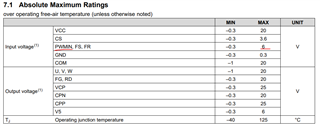Other Parts Discussed in Thread: DRV10983,
Dear Sir/Ms.
We have customers who use DRV10983 to design fans, and the terminal has defective products. It was found that PIN12 (5V) and PIN16 (PWMIN) were burned.
The customer asked the PWM signal to the fan before the 12V power supply, is this OK?
The fan PWM signal continues to give the signal, and then the 12V power supply is supplied to the fan. Is there any problem?
Simulate the usage environment of the end customer:
The PWM of the MCU is connected to the fan, but there is a need to plug and unplug the power cable to measure the signal voltage waveform of the PWM terminal of the fan. PMWIN PIN found the following waveform.


The original 5V voltage of PWM has measured abnormally high voltages of 8.16V and 11.7V.
Is it the main reason for the exception?
If this power-on sequence of DRV11873 is abnormal. And PWMIN will have a voltage higher than 5V, what is a reasonable explanation to convince end customers?
Is there any reasonable explanation for the end customer to understand that this is an abnormal power-up sequence?
Best Regards,
Kami Huang


